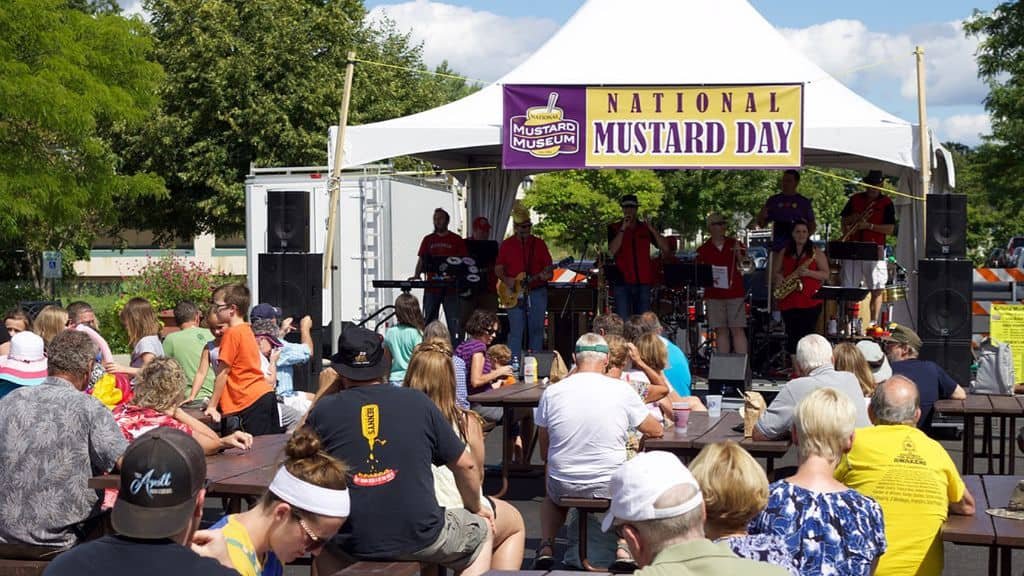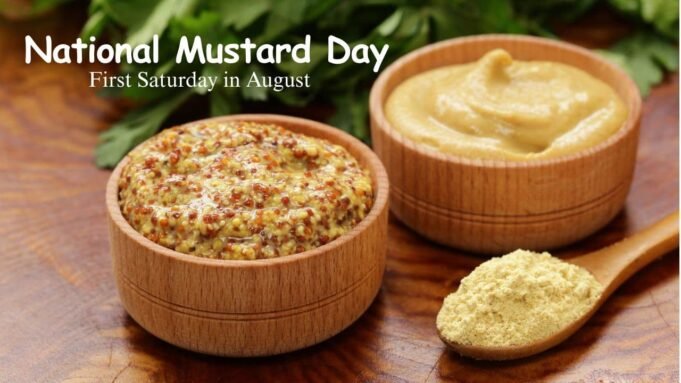National Mustard Day is celebrated every year on the first Saturday in August, spotlighting one of the world’s oldest and most widely used condiments, mustard. This flavorful day honors mustard’s cultural, culinary, and historical significance across different regions. From classic yellow mustard on hot dogs to exotic mustard oils in Indian cuisine, this condiment plays a role in kitchens globally.
In the United States, Middleton, Wisconsin, hosts the largest National Mustard Day event at the National Mustard Museum, drawing thousands for food, music, and family fun. In this article, I will share the history, traditions, types of mustard, how to celebrate the day, and everything else you should know about National Mustard Day.
What is National Mustard Day, and why is it Important?
National Mustard Day is an annual food celebration held on the first Saturday in August to honor mustard, one of the most widely used condiments in the world. The day highlights mustard’s rich cultural history and its essential role in global cuisine from American ballpark hot dogs to Indian mustard oils and French Dijon dressings.
Celebrated with food festivals and culinary events, the day emphasizes mustard’s versatility in taste, texture, and application. It’s more than just a condiment; it represents tradition, innovation, and global culinary diversity. The day also serves as a gathering point for mustard lovers through events hosted by the National Mustard Museum in Middleton, Wisconsin, where the holiday was formally established.
Related: National Ice Cream Sandwich Day
Who created National Mustard Day, and what is its history?
National Mustard Day was officially created in 1991 by the founder of the National Mustard Museum, located in Mount Horeb, Wisconsin, at the time. The event later moved to Downtown Middleton in 2010, where it continues to draw thousands of mustard fans each year. While the official holiday began in the 1990s, mustard’s legacy dates back thousands of years. Ancient Egyptians used mustard seeds for medicinal and culinary purposes.
Greeks and Romans adopted similar practices, and by the 9th century, French monasteries were producing and selling mustard widely. The word “mustard” is derived from “mosto,” an unfermented grape juice that was traditionally mixed with ground seeds. In the 13th century, Pope John XXII even appointed a “Grand Mustard-Maker” at the Vatican. By 1904, yellow mustard was introduced in Rochester, New York, and became a staple in American cuisine. The evolution from ancient remedy to modern condiment reflects mustard’s enduring global significance.
Where is the National Mustard Day Event Held Each Year?
The official celebration of National Mustard Day takes place in Middleton, Wisconsin, home of the National Mustard Museum. Originally launched in Mount Horeb, the event grew so large that it relocated to Middleton in 2010. Each year, thousands of attendees gather in the city’s downtown area, where streets are closed off for a family-friendly street festival. The Mustard Museum itself features over 6,000 types of mustard from more than 70 countries, interactive exhibits, and tasting stations.
Middleton has become a national destination for mustard enthusiasts, offering a unique experience that blends culinary exploration, historical education, and local community engagement. The festival also serves as a platform for local charities, supported by vendors and event sponsors.
Read More: National Frozen Custard Day
What Activities Take Place During the National Mustard Day Festival?

The National Mustard Day festival in Middleton, Wisconsin, offers a wide variety of family-friendly activities designed to celebrate mustard in both fun and flavorful ways. The streets near the National Mustard Museum are closed off to make room for food stalls, mustard sampling stations, and live entertainment. Attendees can enjoy hot dogs, brats, and pretzels served with an assortment of mustards from around the world.
The event features live music, games for children, photo booths, and cooking demonstrations. Vendors showcase regional products, and nonprofit booths help raise money for local charities. With thousands of visitors each year, the festival has become one of Dane County’s most anticipated summer events, supported by local sponsors and volunteers.
What are the Different Types of Mustard Used Worldwide?
Mustard exists in many forms across global cuisines, each offering a unique flavor profile, color, and texture. Here’s a comparison of some popular types:
| Type | Description | Common Use |
| Yellow Mustard | Mild, smooth, made from white mustard seeds | Hot dogs, sandwiches, burgers |
| Dijon Mustard | Sharp, creamy, made with white wine | Salad dressings, sauces |
| Spicy Brown | Coarse, tangy, and contains visible seeds | Deli meats, sausages, and marinades |
| Honey Mustard | Sweet and mild, a blend of mustard and honey | Chicken tenders, dips, and glazes |
| Beer Mustard | Made with beer, tangy and rich | German dishes, sausages, and sandwiches |
| Bavarian Sweet | Dark, sweet, and often made with brown sugar or apples | Roasts, Bavarian cuisine |
| Whole Grain | Coarse with unground seeds | Charcuterie boards, sandwiches |
| Indian Mustard Oil | Pressed from black mustard seeds, pungent and spicy | Indian cooking, pickles, stir-fries |
Mustard’s use is not limited to the U.S. and Europe. In India, both the oil and seeds are used for cooking and traditional medicine. In France, Dijon mustard is a culinary staple, while German and Bavarian mustards are often sweeter and richer. Each variety reflects the culture and regional ingredients of its origin.
Related: National Raspberry Cream Pie Day 2025
How can you celebrate National Mustard Day at home?
Celebrating National Mustard Day at home can be just as fun and flavorful as attending the official event. Start by organizing a BBQ or sandwich night with friends or family, featuring different mustard varieties—from spicy brown to honey mustard. Create a DIY mustard tasting board paired with pretzels, cheeses, meats, and vegetables.
Try adding mustard to unexpected dishes like roasted vegetables, deviled eggs, or even mac and cheese. Visit a local grocery or spice store to explore regional or imported mustard brands. For an interactive experience, make your own mustard using ground seeds, vinegar, and spices. Share your creations on social media using #NationalMustardDay to join the global celebration. This is a perfect way to explore flavor and tradition from your own kitchen.
What are Some Easy Mustard Recipes to Try at Home?
Using mustard in your cooking is an easy way to add depth and tang to everyday meals. Here are a few simple mustard-based recipes that highlight its versatility:
- Honey Mustard Chicken
Mix equal parts Dijon mustard and honey with a splash of olive oil. Coat chicken breasts and bake at 375°F for 25–30 minutes. This recipe offers a sweet and savory flavor profile ideal for weeknight dinners.
- Mustard-Glazed Salmon
Combine spicy brown mustard with a touch of maple syrup and garlic. Brush over salmon fillets and broil for 10–12 minutes.
- Creamy Mustard Aioli
Whisk Dijon mustard, garlic, lemon juice, and mayonnaise to make a rich aioli. Perfect for dipping fries or spreading on sandwiches.
- Mustard Potato Salad
Blend yellow mustard with Greek yogurt, dill, and chopped celery. Toss with boiled potatoes for a refreshing picnic dish.
- Homemade Vinaigrette
Combine mustard, vinegar, olive oil, salt, and pepper. Use as a salad dressing or marinade.
Each recipe uses basic pantry ingredients and highlights mustard’s unique ability to balance heat, acidity, and creaminess. These ideas make mustard the centerpiece, not just a side condiment.
Read more: Kadooment Day 2025
How is Mustard Used Beyond the Kitchen?
Mustard is valued not only for its culinary impact but also for its diverse applications outside the kitchen. In many regions, particularly India and Southeast Asia, mustard oil is used in traditional cooking and as a base for massage oils and skin treatments. The oil, extracted from black or brown mustard seeds, is believed to promote circulation and improve skin tone.
Historically, mustard seeds were used for medicinal purposes by the Greeks and Romans, often applied to relieve muscle pain, chest congestion, or arthritis. The high selenium and magnesium content in mustard seeds contributes to anti-inflammatory effects. Mustard poultices—made by crushing seeds and mixing with warm water were used to treat colds and minor infections.
In agriculture, mustard plants serve as cover crops, helping to reduce soil erosion, suppress weeds, and recycle nutrients. Their fast growth and ability to release natural biofumigants make them useful in sustainable farming practices.
These uses show that mustard is not just a food; it’s a multipurpose plant with culinary, medicinal, and environmental benefits.
When is National Mustard Day in 2026, 2027, 2028, 2029, and 2030?
National Mustard Day is observed on the first Saturday in August every year. Below is a list of upcoming dates:
| Year | Date |
| 2026 | Friday, August 1 |
| 2027 | Thursday, August 7 |
| 2028 | Tuesday, August 5 |
| 2029 | Monday, August 4 |
| 2030 | Sunday, August 3 |
These dates are recognized nationally, with the largest celebration held in Middleton, Wisconsin, home of the National Mustard Museum. Many fans also choose to celebrate at home with mustard-themed meals and social gatherings. Planning ahead allows visitors and local participants to enjoy the holiday fully and take part in any related events, recipes, or travel.
Read Also: National White Wine Day
Frequently Asked Questions (FAQs)
What is the National Mustard Museum?
The National Mustard Museum is located in Middleton, Wisconsin, and serves as the central hub for National Mustard Day. It features more than 6,000 varieties of mustard from over 70 countries, along with historical exhibits, interactive displays, and tasting stations. Visitors can learn about the condiment’s global journey, browse a mustard gift shop, and sample unique flavors rarely found in typical stores.
Can you attend the National Mustard Day event for free?
Yes, the National Mustard Day festival is free and open to the public. Held in downtown Middleton, the event is made possible through local sponsors and community support. While food and merchandise may be available for purchase, entry to the event and activities such as games, music, and mustard sampling do not require a ticket.
Is mustard beneficial for your health?
Mustard contains natural compounds such as selenium, magnesium, and omega-3 fatty acids that offer various health benefits. Mustard seeds may help reduce inflammation and support metabolic health. Mustard oil, commonly used in some Asian cuisines, is also applied topically for skin and hair care. While it’s not a cure-all, mustard has a long-standing reputation for both culinary and traditional medicinal uses.
Is mustard ice cream real?
Yes, mustard ice cream is a real novelty food that has been served at past National Mustard Day events. It’s typically a limited-time item created in partnership with ice cream makers for the festival. The flavor combines the tanginess of mustard with creamy, sweet elements to create a unique tasting experience.
Conclusion
National Mustard Day is more than a food-themed holiday—it’s a tribute to one of the world’s oldest and most versatile condiments. Celebrated on the first Saturday of August, the day brings together food lovers, families, and communities to honor mustard’s global impact. From the streets of Middleton, Wisconsin, to home kitchens around the country, this celebration highlights mustard’s role in history, health, and everyday cooking.
Whether attending the official event or exploring new recipes at home, National Mustard Day offers a flavorful opportunity to appreciate a humble spice that has influenced cuisine across continents. Its rich background, wide-ranging uses, and cultural relevance make National Mustard Day a standout observance on the food calendar.
















[…] Related Read: National Mustard Day […]
Comments are closed.